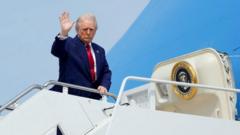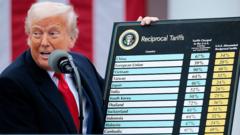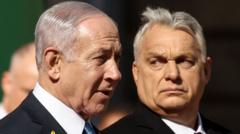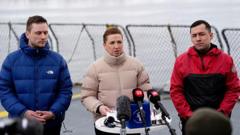The article delves into the contradictory nature of President Trump’s administration regarding its approach to Russia, highlighting moments of both cooperation and tension. As initiatives to improve relations are often coupled with threats and geopolitical maneuvering, the situation reflects a turbulent yet unpredictable diplomatic landscape.
The Unpredictable Landscape of US-Russia Relations Under Trump

The Unpredictable Landscape of US-Russia Relations Under Trump
An exploration into the fluctuating dynamics between the United States and Russia during Trump’s presidency, illustrating the complexities behind political rhetoric and international relations.
As President Donald Trump reignites the rollercoaster of US-Russia relations, significant shifts in diplomacy and policy continue to keep observers on edge. The intriguing interplay of friendship and discontent between Trump and Russian leader Vladimir Putin raises questions about the future of this pivotal relationship in geopolitics.
Since Trump’s return to office in January, his intentions appeared aimed at thawing relations with Russia, demonstrated through direct communications and high-level negotiations. The United States even sided with Moscow in a UN resolution concerning Russia’s actions in Ukraine, signaling an unusual alignment. However, the trend took a sharp turn when mounting frustrations surfaced recently, mirroring a fluctuating emotional landscape akin to a “rollercoaster” ride.
In a notable shift, Trump expressed his disappointment over Putin's suggested "external governance" of Ukraine, indicating a sudden coolness in the formerly amiable dynamic. Finnish President Alexander Stubb’s remarks underscored a dwindling patience for Russia’s actions from the US administration. Trump’s subsequent threats of severe tariffs on Russian oil exports encapsulated this emerging frustration, with bipartisan support for substantial sanctions against those dealing in Russian resources.
The Russian media’s early optimism about improving relations turned as criticism from Moscow surfaced, dismissing the beginning of talks as “administrative insanity.” Publications characterized Trump’s capriciousness on Ukraine negotiations, hinting at a potential rift. Although the announcement of tariffs initially missed targeting Russia, and diplomatic meetings continued, the persistent atmosphere of tension remained prominent.
As Secretary of State Marco Rubio articulated, the US aims to quickly discern Russia’s seriousness regarding peace, reinforcing a cautious yet watchful stance. Allies within NATO echoed similar sentiments, with UK Foreign Secretary David Lammy denouncing Putin’s ongoing military actions against Ukraine amidst claims of unwillingness to embrace a ceasefire.
Rumors of renewed conversations between Trump and Putin highlight the unpredictability of the diplomatic landscape. Observers are left grappling with two central questions: will Trump elevate pressure on Moscow to cease hostilities, and can Putin be compelled to respond favorably? As events unfold in Ukraine, the true test of US-Russia relations rests on the delicate balance of diplomacy and strategy, suggesting that a resolution remains a distant prospect amid swirling uncertainties.






















